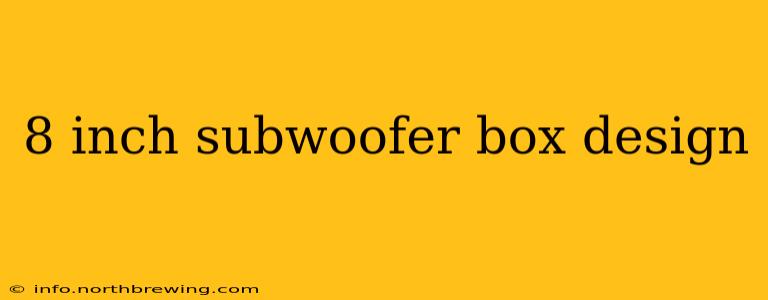Choosing the right subwoofer box is crucial for achieving optimal sound quality from your 8-inch subwoofer. A poorly designed enclosure can significantly hinder performance, resulting in muddy bass, lack of clarity, and even damage to your subwoofer. This guide will delve into the key factors to consider when designing or choosing an 8-inch subwoofer box. We'll explore different enclosure types, their acoustic properties, and how to select the best option for your specific needs and listening environment.
What are the different types of 8-inch subwoofer box designs?
Several enclosure types are commonly used for 8-inch subwoofers, each with its own sonic characteristics:
-
Sealed (Acoustic Suspension): Sealed boxes are simple in design, requiring only a sealed enclosure. They offer tight, accurate bass with good transient response. However, they generally produce less overall output than ported boxes at lower frequencies. They're ideal for applications where accuracy and control are prioritized over sheer loudness.
-
Ported (Bass Reflex): Ported boxes incorporate a port (tube) that allows air to resonate with the subwoofer, extending the low-frequency response and increasing output. They generally produce louder bass than sealed boxes, but the bass can be less controlled and potentially "boomy" if not designed correctly. Careful port tuning is crucial for achieving optimal results.
-
Bandpass: Bandpass enclosures are more complex, using two chambers and two ports to create a resonant frequency band. They offer high output within a specific frequency range, but their design is more challenging and requires precise calculations. They are less common for 8-inch subwoofers due to their complexity.
-
Horn: Horn-loaded enclosures use a horn-shaped structure to efficiently couple the subwoofer's output to the air, resulting in very high output levels. However, these are typically very large and are rarely used for 8-inch subwoofers.
What size subwoofer box do I need for an 8-inch subwoofer?
There's no single "perfect" box size for an 8-inch subwoofer. The ideal volume depends heavily on the subwoofer's specifications (specifically its Vas, which represents the equivalent compliance of the speaker's suspension) and the desired enclosure type. Always consult your subwoofer's specifications and the manufacturer's recommendations. Many manufacturers provide recommended enclosure volumes for their specific 8-inch subwoofers. Online subwoofer box calculators can also be helpful, but use them cautiously and double-check the results.
How do I calculate the right box size for my 8-inch subwoofer?
Accurate box design requires understanding several parameters, including:
-
Vas (Equivalent Compliance): This parameter, found in your subwoofer's specifications, represents the air compliance of the speaker. It is crucial for calculating the appropriate box volume.
-
Qts (Total Q): This parameter describes the damping of the subwoofer's mechanical system. It is used to determine the appropriate box design.
-
Fs (Resonant Frequency): This is the frequency at which the subwoofer resonates naturally.
Using these parameters, specialized software or online calculators can help determine the optimal box volume and port dimensions (if using a ported design). Incorrect calculations can lead to poor sound quality or damage to your subwoofer.
What materials should I use to build my 8-inch subwoofer box?
Medium-density fiberboard (MDF) is the most common material for subwoofer enclosures. It offers a good balance of stiffness, density, and affordability. Particleboard is less desirable due to its lower stiffness. Ensure the MDF is appropriately thick (at least ¾ inch or 19mm) to minimize unwanted resonance and vibrations.
How do I choose the right port for my ported subwoofer box?
For ported designs, the port's length and diameter are critical for achieving the desired tuning frequency. Incorrect port dimensions can lead to unwanted resonances and poor sound quality. Specialized software or online calculators can assist in determining the optimal port dimensions based on your desired tuning frequency.
What are the common mistakes to avoid when building an 8-inch subwoofer box?
-
Ignoring manufacturer recommendations: Always consult your subwoofer's specifications and the manufacturer's recommendations before designing your enclosure.
-
Using inappropriate materials: Using low-quality or unsuitable materials can compromise the sound quality and durability of your enclosure.
-
Incorrect calculations: Inaccurate calculations for box volume and port dimensions can lead to poor sound quality or damage your subwoofer.
-
Poor construction: Sloppy construction can lead to unwanted resonances, vibrations, and leaks, which can affect the sound quality.
By carefully considering these factors and following the guidelines above, you can design or choose an 8-inch subwoofer box that delivers optimal performance and enhances your listening experience. Remember, accurate calculations and high-quality materials are key to success. If you're unsure about any aspect of the design process, it's best to consult with an experienced audio professional.
